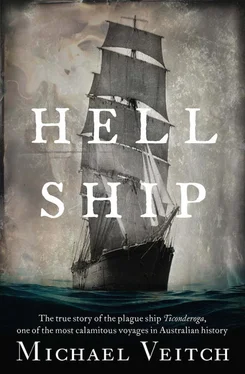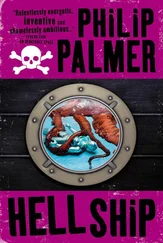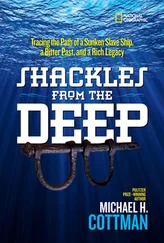This fleeting glimpse of the Lima would be the Ticonderoga ’s only contact with the rest of the world for her entire voyage. Following the Great Circle route to the bottom of the world, she would sight no other vessel until she reached Port Phillip.
On the deck, the passengers began to disperse quietly, but a number lingered, still trying to keep the Lima in sight even long after she had disappeared. The initial flurry of excitement was soon eclipsed by a sense of loneliness—even dread. Once more, the terrible heat of the day weighed in upon them, and people—even the women—loosened or even removed as much of their clothing as they dared. Some prayed for the relief of a cool breeze, wondering whether this heat would ever end. They need not have been concerned. Having sweltered through the tropics, the mercury would now plunge as the Ticonderoga continued south, and her passengers would once again be afflicted by conditions beyond their imagination—this time, in the frigid latitudes of the Roaring Forties.
From the time of the passage of the First Fleet to the gold rush more than 60 years later, the route from England to Australia was prescribed by the Admiralty and not a subject anyone thought required much debate. And it was slow. In stately fashion, ships leaving British ports and travelling the 13,000 or so nautical miles to the Antipodes would call in at the island of Tenerife off the northwest coast of Africa, then drop in further south at the Cape Verde Islands, saunter across to Rio de Janeiro, restocking once more before heading east again to Cape Town on the southernmost tip of Africa. From here, after a stop enjoying the gentle climate of the famously beautiful town, ships’ masters would steer their vessels straight across the Indian Ocean at the Admiralty’s recommended course of 39 degrees latitude. [1] Charlwood, 1981, p. 20
Across this final leg of 7000 miles of empty Indian Ocean, sailing roughly equidistant between the Indian subcontinent to the north and the mass of Antarctica to the south, landfall would eventually be made somewhere close to the southern tip of Western Australia.
After 1817, Rio was finally given up, but the sojourn in Cape Town remained. As ships became faster, however, and the demand for speed greater, all this was to change. On each side of the Atlantic, two brilliant minds—one a watchmaker’s son from Plymouth, the other an American naval officer whose sailing days were over due to a badly broken leg—would usher in a revolution on the high seas.
Anyone observing an atlas could be forgiven for deducing that the shortest distance between two points should be a straight line. The Earth being spherical, however, makes this a delusion. It was the Englishman, John Thomas Towson, who first proposed using the Earth’s curvature to significantly shorten long shipping routes such as that from England to Australia, along roughly the same principle that determines that travelling from A to B around the base of a mountain can sometimes be shorter than going over the top.
Towson’s genius was indeed wide ranging: he had earlier discovered many of the principles of early photography, including the method by which an image can be preserved on a sheet of glass, the use of the reflective camera and the development of photographic paper. Having exhausted his interest in this field, in 1846 he turned his attention to the principles of navigation, presenting his ‘Great Circle’ theory in a compact but enormously important book, Tables to Facilitate the Practice of Great Circle Sailing, which he convinced the Admiralty to publish in 1847. For the first few years after its release, it remained little more than a tantalising theory, with no ship’s master actually daring to follow Towson’s radical path, as it required them sailing to parts of the world to which neither they nor anyone else had ever ventured—or particularly wanted to.
Instead of leisurely hugging the coast of Africa down the Atlantic, then turning left and following a line straight to Australia, Towson’s theory permitted a ship travelling to Australia from England to make no stops whatsoever, the route being sufficiently shortened for the ship’s provisions to last the distance. His Great Circle by-passed Teneriffe, ignored Cape Town completely, then continued way south before swinging to the north-east along a line that still left the south-west corner of Australia thousands of miles to the north. Although covering a much shorter distance, this Great Circle meant that ships needed to touch latitudes of 40 and even 50 degrees south, where the winds howl in an endless easterly gale around the bottom of the globe, unencumbered by any feature of land, propelling the ship like a slingshot across to Australia and beyond. If his theory was correct, the speeds that could be attained would allow a ship in the last third of the journey to cover the same distance in nautical miles as it had during the first two-thirds.
Towson’s Great Circle was not perfect in practice, however, as the theory in its purest form required following a single curve across Antarctica. Instead, he broke it down into a shorter series of smaller curves, or ‘rhumbs’. However, as a compass needle was not able to follow a curved course, great navigational skills were required by the master to determine the precise moment the ship needed to change direction. For this reason, Towson’s Great Circle remained unattempted for a full three years after he revealed it to the world. Finally, in 1850, a Captain Godfrey backed both his ship, the Constance , and his navigational acumen, and attempted the journey. He reached Adelaide in a new record of just 77 days. [2] Charlwood, 1981, p. 21
The Admiralty, though impressed, still demurred, unwilling to alter its official route. For this, it required more proof, which was duly provided by the great American navigator Matthew Fontaine Maury, the man dubbed the ‘Father of Modern Oceanography’, or even ‘Pathfinder of the Seas’. He wrote, as part of a ground-breaking study of oceanic wind and current patterns:
The Admiralty route to and from Australia is one of those tedious old routes, but very difficult to break up, because of the weight and authority which everything with the imprint of that ancient and renowned board upon it has with its navigators. [3] Charlwood, 1981, p. 23
This study provided him with a theory that would bolster that of Towson.
Maury had spent a good deal of time at sea, fascinated by the patterns of the winds and currents he observed. At 33 years of age, however, a stagecoach accident broke his right leg and condemned him to a shore job for the rest of his career. Not really knowing what to do with him, in 1842 the US Navy put him in charge of its Depot of Charts and Instruments in Washington, where he essentially became a librarian. The posting was a perfect fit.
In dusty vaults and forgotten trunks, Maury discovered thousands upon thousands of ships’ logs, dating back to the very beginning of the navy, compiled by long-dead captains who recorded winds and currents across all the world’s oceans during all times of the year, going back nearly a century. Maury categorised them and, most importantly, studied them, poring over countless notations on winds, sea drifts and currents. In the days before computers, Maury’s achievement of assembling the information into a coherent pattern was extraordinary. Slowly, he began to understand what was taking form in front of him, and in his ground-breaking 1847 study Wind and Current Chart of the North Atlantic , put it all together. Later, he would even use information gathered from the diaries of whalers to determine that these creatures actually migrated from sea to sea—a previously unknown fact—and from that deduce the likelihood of a north-west passage across the top of the American continent.
Читать дальше












